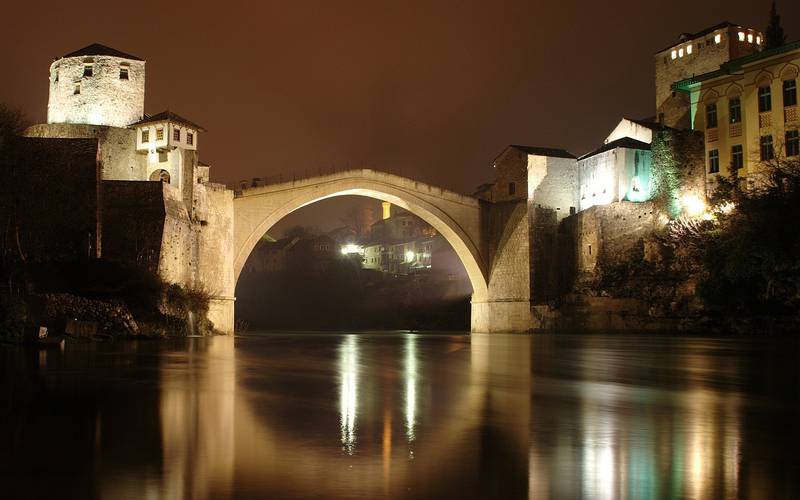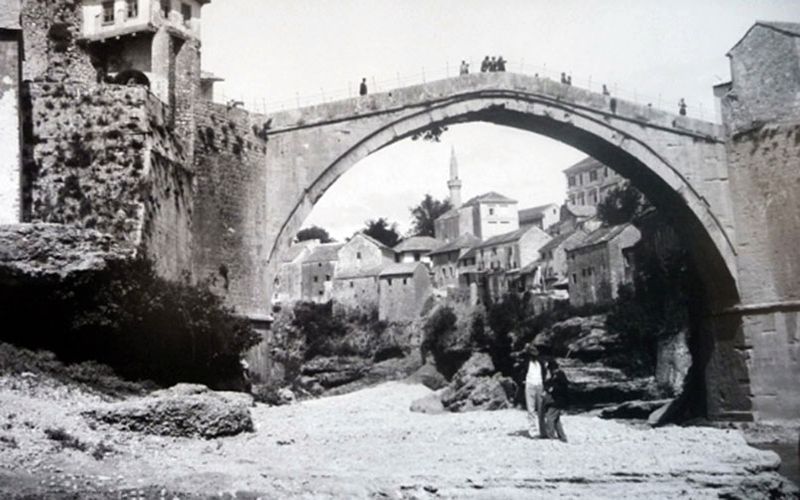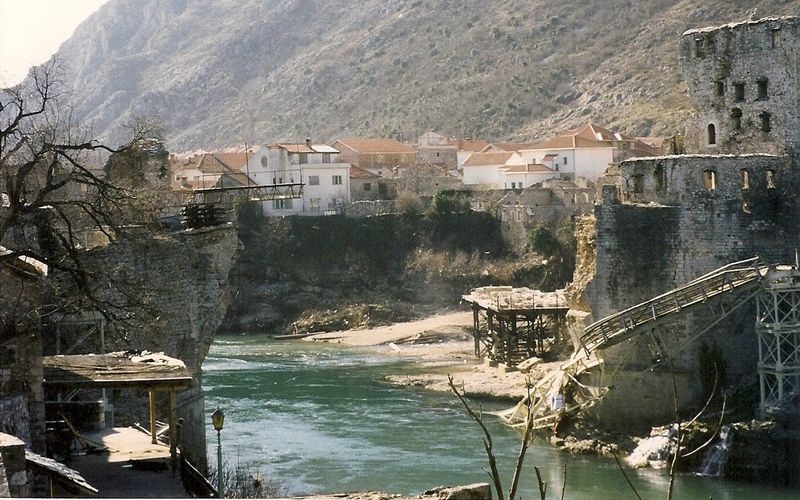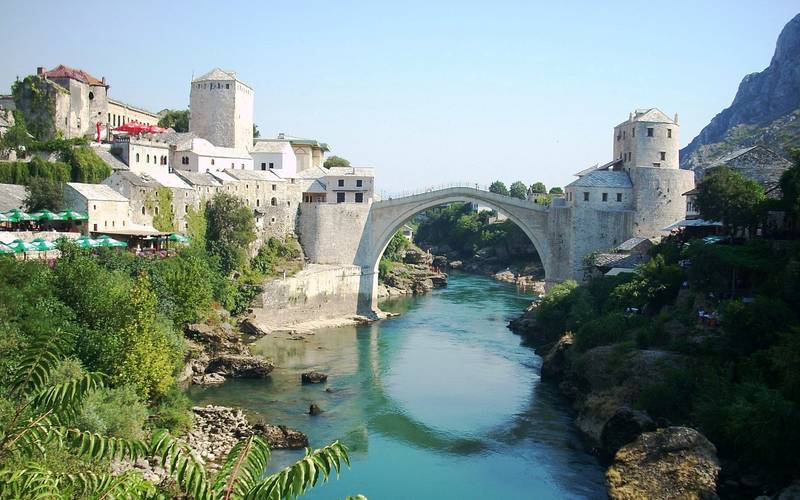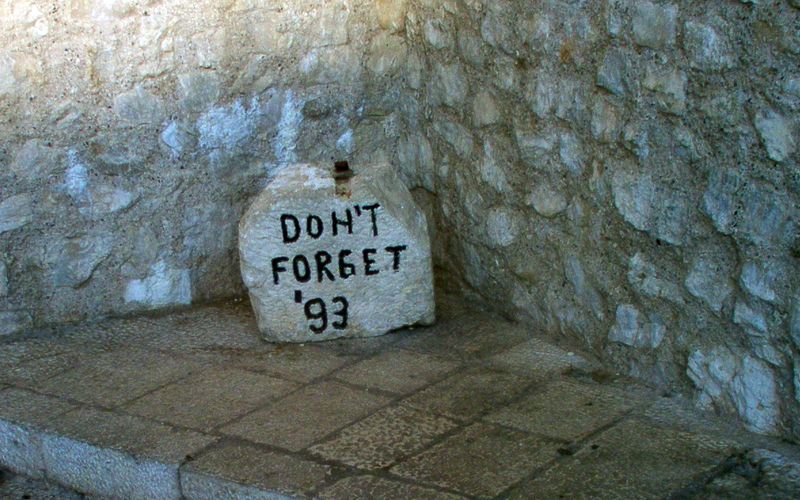The "Stari Most" as it is called locally is a construction dating from 1566. It is the work of Mimar Hajrudin , a pupil of the famous architect Sinan, father of classical Ottoman architecture to whom we owe a large part of mosques of Istanbul.
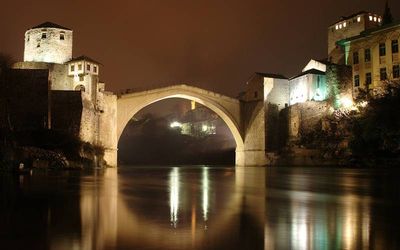
Stari Most
The bridge during ancient times
Mimar Hajrudin is known only for the construction of this bridge, the story did not leave us other buildings that he could have built. The legend says that once finished he fled the city just before the workers remove the scaffolding: Indeed, it is said that he would have been killed if the bridge had collapsed during this sensitive phase ! In any case the bridge's construction period was 9 years, from 1557 to 1566. Other sources tell us that it would have lasted only a year, but in the working conditions that were workers of the region in the sixteenth century, it's hard to believe. Especially at the time, the cold was more intense than nowadays. To re-situate the context of the archives indicate that this place was a site inhabited since ancient times, without stopping. At the beginning of the 15th century it sheltered a fortification which served to protect the population. Between 1450 and 1475 the city was taken by the Ottomans who built a Muslim neighborhood north of the present bridge, near the river. To move from one bank to the other one used then a suspension bridge which probably had to be renewed regularly. Still, in 1566 the final bridge will be built, bringing the two banks closer together more efficiently.
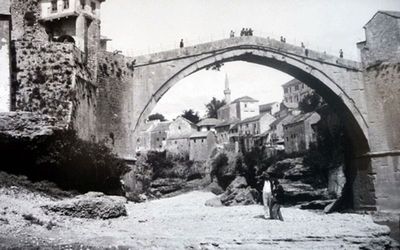
Stari Most in 1896
One of the few events to report about its history is the addition, during the seventeenth century, of the two doors East or West. These are the fortified towers Helebija (on the right bank) and Tara (on the left bank) that can still be seen today, although they have been partially rebuilt since.
The history of the bridge is not particularly interesting until 1993 because it has always been in state, never being damaged, destroyed, nor rebuilt until modern times. It can still be said that the city experienced a commercial and demographic influx when Bosnia and Herzegovina passed under Austro-Hungarian rule, and saw Nazi tanks pass through during the Second World War. Moreover, it should be noted that the bridge did not flinch when the heavy tanks of the second world war crossed it, proof of its solidity.
Background: The Balkan War
The Mostar Bridge was destroyed during the war in the former Yugoslavia, between 1991 (Beginning of Armed Conflict ) and 1995 (Dayton Agreement). The conflicts continued for a few more years, but in peripheral regions and in lesser degrees, that is why the end of the war was generally fixed in 1995.
The reason of the conflict was born in the geopolitical situation left by Tito, the former Yugoslav dictator who held in one country, many e different thnies: Serbs, Croats, Bosnians, Kosovars, Macedonians, etc. When the Soviet bloc fell in 1991, the republics affiliated with it fell with it. But in the case of Yugoslavia, the problem was the deep entanglement of different populations. As the Balkan populations were strongly interwoven territorially, the formation of new nations was inevitable, but the borders of each of them necessarily had to encroach on its neighbor, each nation having reasons for the recovery of a territory. It was the Serbs who first opened hostilities by claiming their rights over Bosnian territory. It must be said that if the Cro a tie and Serbia were heavily populated by people from their communities, it was less the case in Bosnia where lived an e strong Serbian community. The objective of the Serbs was to create an independent Serb Republic within Bosnia, which was temporarily accepted in an attempt to stop the armed conflicts there. The Croats, also claiming their independence, also entered into armed conflict with the Bosnians. On their front line, in the south of Bosnia ... the city of Mostar was an important goal.
Indeed, in this cosmopolitan city composed of different neighborhoods with well-defined ethnic groups, the population lived in a strong mix. The lines of communication facilitated the exchanges, and the city lived peacefully. Arrived on the spot the Croatian forces besieged the old city, to the east of the local river, the Neretva, a district inhabited by Bosnians. But these were fed live s and weapon s the old town bridge, the historic bridge. To avoid this supply the Croats did not hesitate: They took the decision to destroy it.
Learn more about the reasons for the destruction of the bridge.
November 9, 1993: Its destruction
So we are on November 9, 1993. The city of Mostar is the target of Croatian forces who want to take the district of the city center , the Bosnian historic district. If he falls, the Bosnians will be forced to flee, leaving not only the city to the only Croatian inhabitants, but bringing down the whole region, which would then pass in the hands of the Croats. Croatia's borders could have gone much further than they are now.
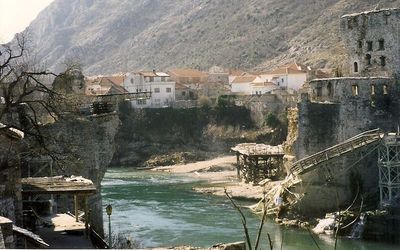
The bridge after destruction
The Croatian artillery is pounding the bridge the night before: It is a deluge of shells falling down. The order is given by the Croatian general Slobodan Praljak . Some do not reach their target, but most are hit. Gradually the stones collapse, then the bow falls in the Neretva, the 9 in the morning. The defensive towers are also strongly affected, it is the whole neighborhood that sinks into chaos for a few hours. When calm returns the population can not but note: Their bridge is destroyed.
La reconstruction
The first call for the reconstruction of the Mostar Bridge was launched on 10 March 1994, only four months after its destruction, and while the conflict was not over. In June 1994 a delegation arrived on site to assess the emergency measures to be taken. Fortunately the Dayton Accords, signed in December 1995, put an end to the war. It states that national monuments will be under supervision of a committee commissioned e by UNESCO. It is in this context that in July 1998 UNESCO issued an official appeal to add a fund for the reconstruction of the bridge, estimated at more than 12.5 million euros. The following 5 countries replied:
- The World Bank: 4 million
- Local authorities: 2 million
- Italy: 3 million
- The Netherlands: 2 million
- Croatia: 0.5 million
- The Council of Europe Development Bank: 1 million
It is the local authorities who organized the site, gérèrent funds and put in place the measure s practices. The World Bank ensured the centralization of funds and UNESCO was responsible for scientific and technical coordination. An International Committee of Experts was appointed in October 1998, the project was set up.
The work really began on June 7, 2001, after the scientific committee finished its work and gave its prerogatives for the reconstruction. Until June 2002, the work consisted in removing stones from the bed of the Neretva, not only because they were at risk of cluttering the river, especially in case of high flood, but the stones were to be reused are under the reconstruction, at least partially. From June 2002 construction work began. On April 14, 2003 the first stones of the ark were laid. Work continued until July 23, 2004, the day of its inauguration.
The construction techniques were very specific. The idea was to reconstruct the bridge identically, so it was necessary to use, as much as possible, construction techniques similar to those that had been used in 1566. For that we began by choosing identical stones, the type " tenélija "and" bretcha ". They were extracted from local quarries in the territory of Mostar. Then they were cut with voussoirs, crampons and tenons, old tools of the time. Moreover, about the size of the stone, it should be known that the authorities opened for the occasion stone-cutting schools specifically to train inhabitants of the region to these techniques more or less forgotten, and that in order to not having to bring workers from countries like Italy or France, countries that make reference in this matter.
In addition, the engineer in charge of the definition, coordination, and supervision of studies for the reconstruction of the Mostar Bridge, Mr Gilles Pequeux , insisted that the workers should come not only from the city of Mostar, but on both sides of the bridge, to ensure the diversity of the population. He pointed out quite rightly that this bridge was so important to the inhabitants that its destruction was seen as the loss of a loved one, requiring mourning. This word did not seem to him overestimated at the time since some inhabitants did not even want to see the damage, considering that the shock would be too important. Suddenly rebuilding it quickly also caused misunderstandings among some inhabitants, who raised the question of the interest of its reconstruction, however obvious. Moreover, the choice that was made to rebuild the identical is significant that the inhabitants wanted to forget as soon as possible the episode of its destruction, preferring to see their intact bridge rather than imagining another bridge, more modern .
So the bridge of Mostar was rebuilt identically.
The inauguration (July 23, 2004)
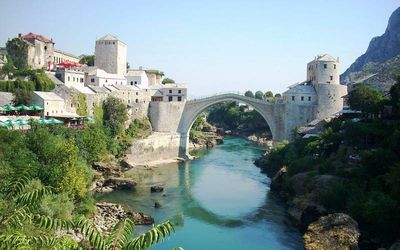
Stari Most
The inauguration of the Mostar Bridge took place on 23 July 2004 in the presence of many foreign leaders. There were the Presidents of Albania, Bulgaria, Croatia and Serbia and Montenegro as well as the French, Italian and Dutch Foreign Ministers, whose countries had respectively participated in its reconstruction. There was also Jacques Paul Klein, the special representative of UN Secretary-General Kofi Annan.
The ceremony began with the Bosnian national anthem, followed by some speeches. Then, symbolically, the leaders crossed the bridge. The evening ended with fireworks. The main message was firmly told there was one of reconciliation, because even though the war was nice e t finished well e even if the wounds were dressed, there still existed at that time a lot of resentment s between different communities viv have in Bosnia. Bosnian President Sulejman Tihic at the time did not hesitate to say that this bridge should serve to "strengthen the foundations of a multi-ethnic , multi-faith and multicultural Bosnia where Eastern civilizations meet. and West ".
The Bridge Today: Role and Situation
High place of tourism
The city of Mostar is not specifically known and Bosnia is not, either, particularly tourism that the old bridge was t served as a symbol was an opportunity to develop tourism.
Nowadays the bridge of Mostar has become a tourist hotspot where many foreigners eager to enjoy the calm of the old city, in a soothing architecture. But mass tourism is not compatible with serenity, and it must be admitted that during certain periods of the year, the center of Mostar is a real hive noisy, even stifling.
Communities always separated
This bridge has also become, thanks to its destruction and its reconstruction, a symbolic place. Having made it possible to connect the different Croat, Serbian and Bosnian communities within the same city by making everyone communicate, its destruction was intended to separate these communities in order to increase the independence of all (and more particularly Croats, at the origin of its destruction). By its reconstruction, the international community hoped to restore the city's cosmopolitan character. Alas, in the meantime the inhabitants of Mostar have largely changed: Serbs and Croats left, for the most part, and the old quarter is less and less a Bosnian community with strong identity. The need for communication between the communities is no longer a matter of course for the generation that experienced the war, and in this, the Croats at the origin of the attack succeeded. The mix is now severely limited in Mostar, and that despite the recovery of this important thoroughfare between neighborhoods.
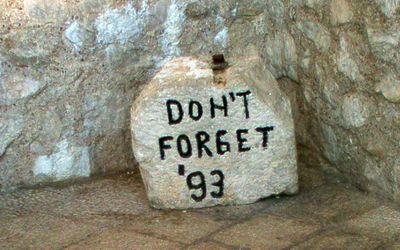
Memorial stele
And this sense of loss of landmark is stronger on the Bosnian side than Serbo-Croatian. Indeed, as historically Mostar is a city in Bosnia, the Bosnians are in the city center and they are the ones who deplore the most the loss of the bridge, because they are the ones who need the most to reconstitute the social mix of the city. In addition, the bridge is of Ottoman origin, therefore Muslim, and Bosnians are predominantly Muslim, so there is a cultural coherence between their community and its bridge that corresponds to them, historically and culturally. On the contrary, the Croats, essentially Christian, reject it and see it as a Muslim symbol they prefer not to see. Its identical reconstruction did not raise masses of approval at the time.
Besides, the separation of Croats and Bosnians in Mostar is visible physically. On the Bosnian side, the elected officials have repaired the many minarets, both fine and tall, in the eastern district. Opposite, the Croats built an immense bell tower, particularly high, adjoining the church of Peter and Paul, a Franciscan church. It's a bit like having to fight a battle, not military this time, through the architecture of the city to assert its dominance. Domination that attempts to be eliminated by the elected officials (the mayor is Bosnian and his Croatian deputy), who took different resolutions to talk again communities between them. Among them, the police, unique for the whole city, is a good example. But in the face of these attempts to mix communities, it must be admitted that there are many points for which the differences are strong. So much that separate services are set up: The post of each community issues stamps that are not recognized by the other community. The city has two football teams. Two hospitals. As if there were two separate cities, physically separate, and whose elected officials could not agree on public services. This ubiquitous situation is a real plague that will only close with time, a priori.
An international symbol
The most visible consequence of the destruction of the Mostar Bridge e s t his passage to status symbol. By being thus put forward, it has become the symbol of reconciliation between peoples. However, and we have seen previously, this reconciliation is, on the spot, only facade. But in the collective imagination, the Stari Most, as it is called here, is a symbol of success. It is mainly used to highlight an example of success in bringing together two opposing peoples. Some leaders use it to try to agree two belligerents on a theater of confrontation, to show that reconciliation is possible. A real role of symbol, therefore.
Learn more about the symbolism of the Mostar Bridge






